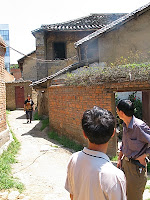Canon PowerShot SD1200 IS: a product review
Tuesday, June 23, 2009
I was slow going digital with my photography. As late as the summer of 2000, I dragged forty roles of slide film and my Nikon SLR for seven weeks across Europe and Uzbekistan. I still hadn’t organized and viewed all those slides when I bought my Canon G3 during the summer of 2003, and now, of course, when I want to use one of those European shots, I first have to digitize it. My G3 has been twice to China and twice to Brazil. It has recorded weddings for my five children, gotten me nearly three years into grandfatherhood, and illustrated these first five years of Capers with Carroll. On a single day in Yunnan, I shot 600 keepers from a bus window. In Pernambuco, I captured 120 images of one male Frigga sp. to get the picture I use at the top of this blog. That would have been a prohibitive four 36-shot rolls of film. I love my G3.
However, in September, I spent some time in the camera section of a big-box electronics store, helping a visitor from C hina choose a pocket-sized digital. Suddenly the G3 felt pretty bulky. My favorite shirt is a guayabera with four pockets. They will hold the G3, but it’s awkward to maintain for more than a few minutes. I usually carry my camera on a belly strap, but that creates other problems. Whether I’m photographing urban wildlife or grand kids, the key to success is to have the camera perpetually at hand. Even as a junior high teacher, whether I want to record evidence against a graffiti artist or a cute candid shot to forward to the yearbook, a camera in the pocket is worth two in the closet.
hina choose a pocket-sized digital. Suddenly the G3 felt pretty bulky. My favorite shirt is a guayabera with four pockets. They will hold the G3, but it’s awkward to maintain for more than a few minutes. I usually carry my camera on a belly strap, but that creates other problems. Whether I’m photographing urban wildlife or grand kids, the key to success is to have the camera perpetually at hand. Even as a junior high teacher, whether I want to record evidence against a graffiti artist or a cute candid shot to forward to the yearbook, a camera in the pocket is worth two in the closet.
 .
. large. For closer studies of insects and spiders, I will continue to use the even higher density capacity of my G3. For those, I fix the camera on a tripod, turn the subject loose on a leaf, manipulate the leaf to achieve focus, and record a superabundance of poses. Spontaneity is not an issue.
large. For closer studies of insects and spiders, I will continue to use the even higher density capacity of my G3. For those, I fix the camera on a tripod, turn the subject loose on a leaf, manipulate the leaf to achieve focus, and record a superabundance of poses. Spontaneity is not an issue.I present to you the new workhorse of this blog.
(For a six-month update, look here.)
Labels: Brazil, China, Entomology, Grandparenting, Photography, Product Reviews, Spiders, Teaching, Travel, Wild Animals
Rowing past San Quentin
Saturday, June 20, 2009
I don’t want to give away the part it plays in my story, but I spent last weekend researching the sport of sweep rowing, especially as it’s practiced in the waters around San Quentin State Prison. The Marin Rowing Association has its boathouse up Corte Madera, in Larkspur, just a few hundred yards west of the prison. Over a year ago, I started following their website. Then, on my last visit to San Francisco, I dropped by and watched the activity as the teams returned from a big race, cleaned up the equipment, and put it away. I tried to stay out of their way, but picked out one fellow to catch in the parking lot with some questions. It was my g reat good fortune to pick Ron Arlas, Larkspur city councilman and former mayor, with rowing experience going back to the 1960s. He has gone over-and-above, not just answering questions, but taking an active interest in my story, offering suggestions, and opening doors. In short, he’s become a friend.
reat good fortune to pick Ron Arlas, Larkspur city councilman and former mayor, with rowing experience going back to the 1960s. He has gone over-and-above, not just answering questions, but taking an active interest in my story, offering suggestions, and opening doors. In short, he’s become a friend.
So last Saturday, with the weather perfect, I got to ride along with the coach in a launch as we followed the morning workout. In this shot, we had already been out near the Richmond/San Rafael Bridge, and were headed back. That’s Ron in seat three from the bow, and East Block of the prison directly over his head.
My pen-pal on Death Row mentioned once that from his cell he could sometimes see the teams practicing. My angle was so much better.
On Sunday, I went back for the two-hour Learn-to-Row workshop that MRA offers. I’ve rowed rowboats and canoes, but these boats offer a different feel, and I wante d to experience it. We began with an hour of land-based instruction, and then proceeded to launch into Corte Madera, four novices with four veterans and our coxswain-instructor.
d to experience it. We began with an hour of land-based instruction, and then proceeded to launch into Corte Madera, four novices with four veterans and our coxswain-instructor.
Research done, now it’s back to writing.






